The Art Lawyer’s Diary: Venice Art Biennale & documenta fifteen – Icons of the International Art World Question the Role of Art and the Artist in Times of Global Crisis
Jun 22, 2022
The Venice Art Biennale: The Milk of Dreams
Barbara T. Hoffman, Esq.*
The 59th edition of the Venice Art Biennale, under the title of “The Milk of Dreams,” opened to the public on April 23 – November 27, 2022. The exhibition takes place in the Central Pavilion of the Giardini and Arsenal. There are also 88 National Pavilions throughout the city. The curator Cecilia Alemani, the first Italian woman to curate the Venice Art Biennale, responds to the convulsions of our time: Covid 19, climate change, disruption of war, loss of community and culture – by asking us to imagine new forms of co-existence with society and its social structures, technology, and nature: how is the definition of the human changing? What constitutes life and what differentiates plant and human? What is the human relationship to technology?
In an interview, Alemani stated:
“There is a lot of spirituality in the show, especially in the historical micro-exhibitions, which I call ‘time capsules’.
One of the pillar themes is the “post-human” inspired by authors like Donna Hardway, who challenges the idea of the individual being at the center of the world. These ideas are about imagining other kinds of relationships, rooted in togetherness and symbiosis.
At Venice Art Biennale, I was looking at artists who were trying to break with the familiar polarities and dualities that came out of the Enlightenment – mind and body, nature and culture, feminine and masculine and so on – to imagine a world that is more fluid and in-between. That is where the occult and the spiritual come in.
The Milk of Dreams takes its title from a book of Lenore Carrington (1917-2011) in which the surrealist artist describes a magical world, which is constantly reenvisioned through the prism of imagination where everyone can change, be transformed, become something or someone else.”
Alemani states, “In this climate many artists envision the end of anthropocentrism… Others react to the dissolution of universal systems, rediscovering localized forms of knowledge and new politics of identities. Still others practice what feminist theorists call the ‘re-enchantment of the world’, mingling indigenous traditions with personal mythologies in much the same way as Carrington.”
Notwithstanding, it is a paradox that Alemani’s focus remains so rooted and anchored in the Western paradigm: the individual artist and the power of art and the artist to help “us” (the viewer) imagine new modes of co-existence and infinite powers of transformation. Alemani’s curation is brilliant, well researched and the source of new discoveries. Women artists of all generations dominate and others without voices are heard. However, spirituality and magic did not start with the Surrealists. Alemani’s focus is on adding overlooked artistic voice and identities to broaden the western aesthetic canon.
Images from Milk of Dreams Illustrate Alemani’s Curatorial Perspective at Venice Art Biennale
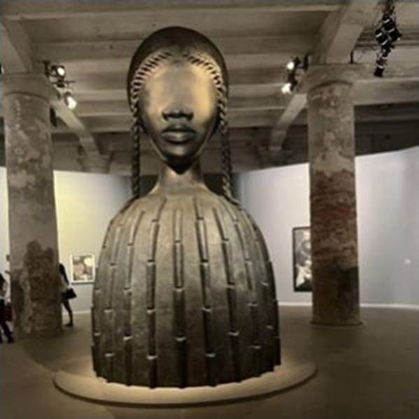
Simon Leigh, USA (2022). The entrance to the Milk of Dreams Exhibition at the Arsenal.
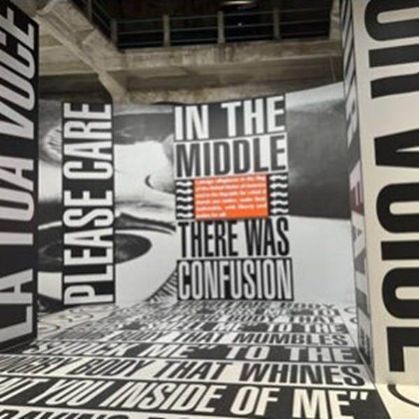
Central Pavilion. Barbara Kruger, Untitled. Beginning, Middle End.
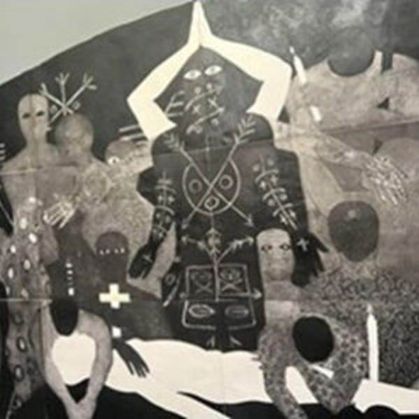
Homage to Belkis Ayon. La consagracion, Havana, Cuba. Arsenales.
documenta fifteen
Founded in 1955 in Kassel, Germany, documenta is a quinquennial international art exhibition that carries heavy intellectual weight in the art world, customarily programmed for a duration of 100 days in venues throughout Kassel. While held in high regard among artists, curators and institutional directors, perhaps less so among collectors and dealers given its often more academic, intellectual and less market-friendly nature. Normally, the artistic director is a well-recognized international curator: Adam Szymczyk (14); Catherine David,Pompidou Paris 1997 (10); and Okwui Enwezor 2002 (11).
Breaking with this tradition, documenta fifteen poses a radical artistic response to the world’s crisis, at first encounter, a seismic shift in envisioning not only the role of the site and the exhibition, but the very role of the artist and the systems of art production. documenta fifteen is not theme based. It is about process and practice: how do people create the material and immaterial infrastructure they need to nurture and sustain themselves and their ecosystems?
documenta fifteen takes place from June 18 to September 25, 2022, under the Artistic Direction of ruangrupa at 32 venues in Kassel, Germany. The Jakarta-based artist collective has built the foundation of documenta’s fifteenth edition on the core values and ideas of lumbung, the Indonesian term for a communal rice barn.
The Indonesian word ruangrupa loosely translates as “art space.” ruangrupa’s work is based on a holistic social, spatial and personal practice that is strongly rooted in Indonesian culture, where friendship’s solidarity and community are of central importance.
lumbung as an artistic and economic model is rooted in principles such as collectivity, communal resource sharing, and equal allocation and is embodied in all parts of the collaboration and the exhibition. lumbung is the concrete practice adopted by ruangrupa and the Artistic Team, lumbung members and lumbung artists and all participants on the path towards documenta fifteen, throughout its 100 days and beyond.
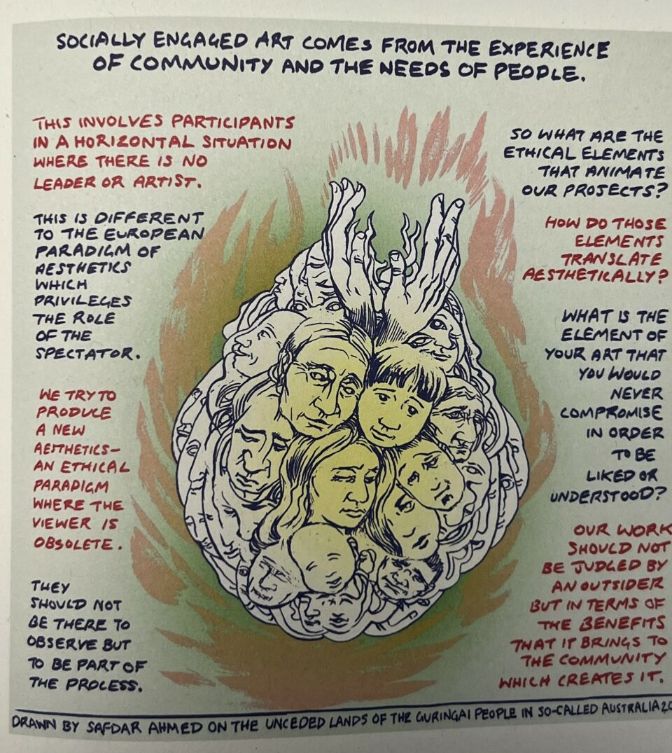
The focus is on art as process, and the artist as social activist who mediates between the artist’s engagement with social issues and the community.
“We want to create a globally oriented, collaborative and interdisciplinary art and culture platform that will remain effective beyond the 100 days of documenta fifteen. Our curatorial approach strives for a different kind of collaborative model of resource use–in economic terms but also with regard to ideas, knowledge, programs and innovations.” – ruangrupa
The artist is seen as mediator, and “now we are looking back and asking, ‘what is harvest?’”
14 lumbung members or artists collectives and 53 lumbung artists participate in documenta fifteen. In turn, these artists have been to include their networks.
ruangrupa and the artistic team are aware of the paradoxes in this event. In documenta fifteen, lumbung is still approaching the economy using old paradigms. documenta fifteen is still using the language of and can be understood as a conventional/mega event despite the artistic attempts to approach it as more bottom up. Notwithstanding, the aim here is ultimately the community,ruangrupa stated “lumbung is not only ours now… Own it, and make your own lumbung – ultimately, then, the energy and power of becoming and being is transmitted by the artistic experience transcending the boundaries which divide us to connect us in spirit. The practices and methodology are different.”
Thus, in the opening press conference, the artist Agus Nur Amal PM Toh informs us of his project with students in Kassel which facilitates a series of storytelling sessions based on the Sudanese life principles, Tri Tangua: “Public space contains a multitude of narratives, all competitions for how they can function as truth within the context of an authoritarian state or one where the powerless have no media access, native histories become a site to find answers.”
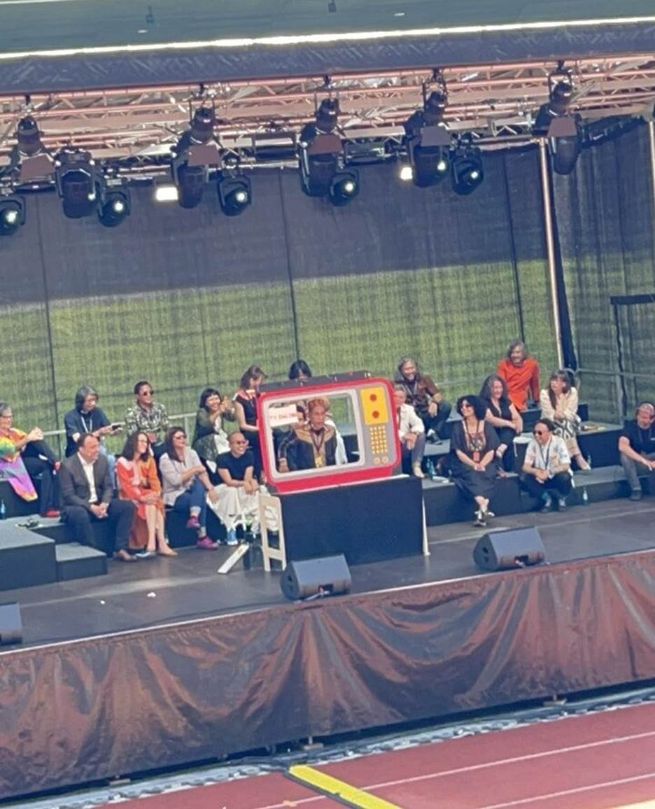
Press conference performance
documenta fifteen takes place in three geographic zones of Kassel: (1) Mitte, the central city part – museums, Fridericianum***, documenta halle***, WH 22; (2) Fulda – Hafenstrasse 76 and (3) Bettenhausen*** – The Fondation Festival Sur le Niger*** (Hubner-Areal) and Atis Rezistans | Ghetto Biennale *** (St. Kuniqundis).
*** Don’t miss these.
Fridericianum (Mitte)
For the duration of documenta fifteen, the former exhibition building has become Fridskul (Fridericianum as school) and is being used by artists and collectives to apply and demonstrate different models of horizontal education that are rooted in life. ruangrupa see it as a – a practice of sharing and a form of architecture often used to store harvests in Indonesian. As a lumbung, as both a domestic place and a social space where all can gather, the cold museum space of the Fridericianum becomes a warm and dynamic place. Artists are sleeping at Fridericianum, eat there communally and hold student encounters at the space.
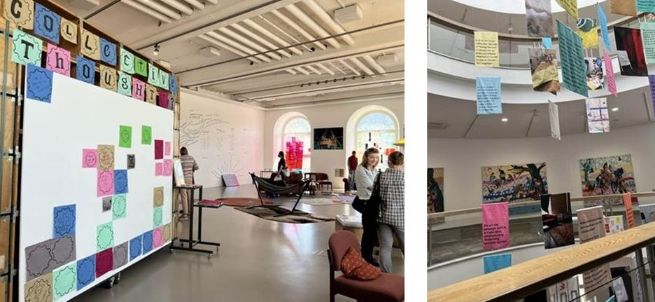
documenta Halle (Mitte)
Wajukuu Art Project
documenta fifteen advocates for the collective to substitute for art institutions. However, the idea of the collective making individual artworks is more complex and nuanced and warrants further discussion based on each collective’s processes.
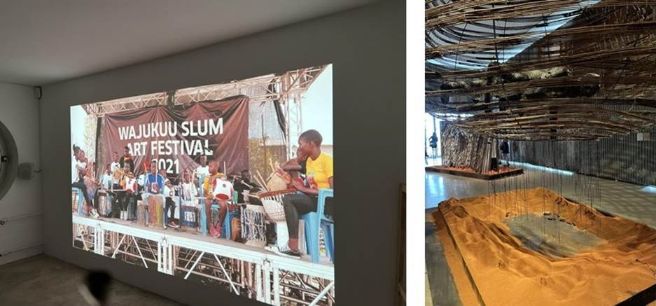
Wakjuu Art Project. Wakija Kwetu (When they come to our place), 2022. Mixed-media installation.
Artists in the Wajukuu Art Project have created not only as a collective but as these images reveal, have created powerful works of artistic authorship based on a new aesthetic of the slum and its materials. Wajukuu Art Project’s architectural installation is a tunnel inspired by both Makuru traditional housing and informal aesthetics of the slum. Aesthetic values rest on cultural heritage, cultural attitudes and accessibility of materials.
Britto Art Trust
The Bangladesh-based Britto Arts Trust creates a bazaar, a family kitchen and a large-scale mural all exploring geopolitics, land rights and food.
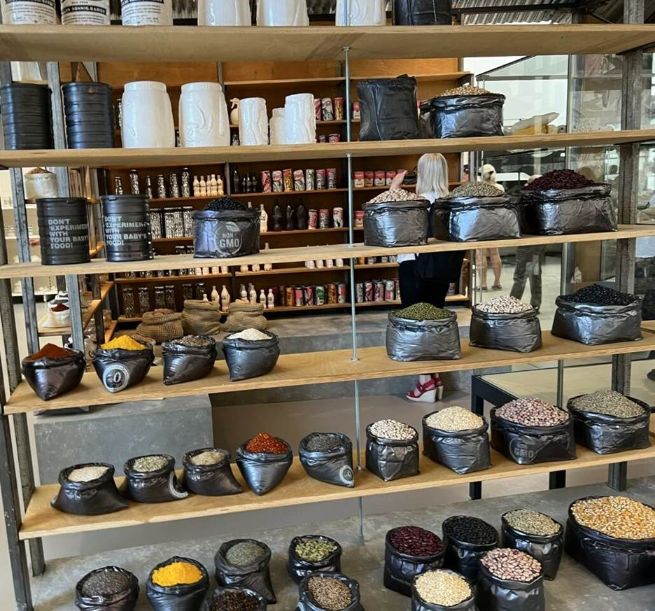
The small-town bazaar recreation rasad 2022 underscores how each hand made object becomes precious to the contrary of the reality where food stuffs are divorced from natural origins and survive only through chemical conditioning and false environments.
Bettenhausen
La Fondation Festival Sur le Niger (Hubner-Areal)
At this time of dislocation and social upheaval, global pandemic, the crumbling of our international legal order and its institutions, immigration, destruction of cultures in the wake of globalization, documenta provides guidance. The Fondation Festival Sur le Niger, founded in 2009 by Mamau Daffe and its individual artists, look to traditions, music and social practices as a means of identity and social cohesion.
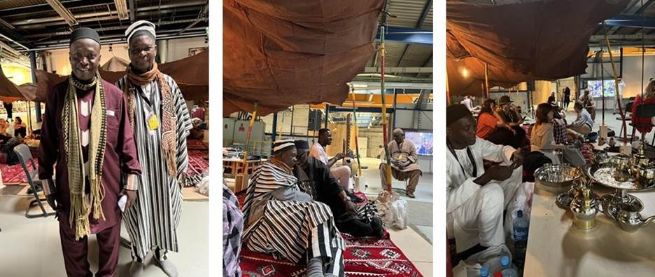
Guest and hosts at the presentation of the Maaya bulon and tea ceremony: Yaya Coulibaly, Abdoulaye Konate, Salia Male, Adama Keita, Mamou Daffe, founder. The degree of local support for the festival and the spirit of entrepeneurship is evident by the presence of the mayor of Sekou.
Performa, the New York performance Biennale introduced in its last biennale the importance of the role of architecture and architectural space as an element of visual performance artists. Traditional Malian culture recognized the bulon as a sacred space and social structure as early as 1653 with the founding of the Mali empire. The Bulon symbolizes the heart, the past, and the present of the family, a place of decision making and community with the ancestors. It is also a space for teaching and transformation. In this sense the Fridericianum also becomes a Bulon space. “True art,” writes Andre Breton, the Surrealist, “is the one that strives to give expression to the inner needs of man and humanity.” While Alemani’s inquiry begins with and credits the Surrealists, for this new art aesthetic, documenta fifteen takes us to more ancient cultures. The Maaya is an integral concept of humanity based on the relationship of the individual and the community. This is a convergence of views where the function of art and social practice are the same.
Atis Rezistans | Ghetto Biennale (St. Kunigundis Church)
One of the most powerful installations is created by the collective Atis Rezistans from Haiti. A fluid collective of artists, working in the Grand Rue neighborhood of Port au Prince, Haiti, the collective was founded by sculptors Andre Eugene and Jean Herald Celeau in the late 1990’s. Coincidentally, my client in the famous case of AFP v. Morel was with Andre teaching art students during the 2010 earthquake that sparked the case that established photojournalist rights on the internet based on the Twitter TOS. The sculptures embody the spirit of the collective – the style derives from popular culture, Haitian history and voodoo using a range of found objects, mostly what is available in this country for artistic production.

Barbara Hoffman with Evel Romain and founder Andre Eugene
There will be those who ask is this a proper role for documenta? This small sized town in Germany of under 250,000, for more than 75 years has provided intellectual content to the art world as an agent of thought and discussion. Could this have been a conference or a symposium? Maybe. But it is a work and experiment in art making that is important. It is, as was said, not the last documenta but the first lumbung.
The seeds of what is germinated here have yet to fully harvest. However, kernels can be found in artist activism in the U.S as either the practice or a practice of sharing with the community. One has only to look at the number of artist-endowed foundations, the renewed study and importance of archives, and the focus on artist residencies and leisure time, conversations and storytelling. Black Quantum Futurism, based in Philadelphia, is a documenta lumbung inter lokal member represented by three projects sourced in African diaspora, nonlinear temporalities, quantum physics and housing futures as framework. Numerous artist-endowed foundations supplement individual artistic practice to use foundations as a community-centered artistic practice or to provide artistic residencies for artists to think and reflect. Derrick Adam’s Charm City Cultural Cultivation Inc. embodies such lumbung themes as the importance of leisure time and conversation and the power of archives as identity to regenerate and cultivate the rich traditions and culture of Baltimore. Its Last Resort Artist Retreat residency subscribes to the concept of leisure as therapy for the black creative, Titus Kaphar’s NZTHVN, provides an arts model that empowers artists and curators, education and access to a vibrant ecosystem to create a sustainable art community in New Haven. Art as social practice and process – the spirit of lumbung- may not replace biennales or art fairs, but it is a present and a future and awaits the harvest.


